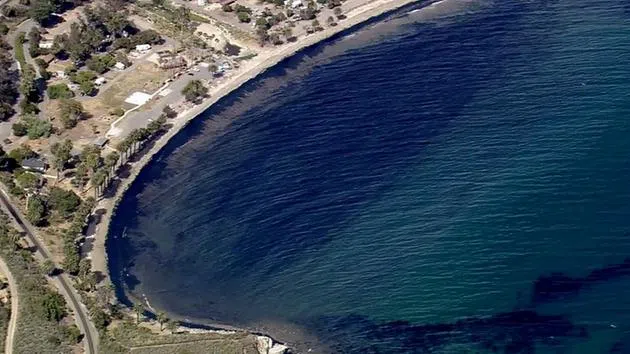LOS ANGELES (AP) — The leader overseeing a massive oil cleanup along the California coast defended the initial response, saying there were workers on the ground after the spill that stained popular beaches.
The first wave of workers deployed booms in the water to corral the oil slick and placed them along the shoreline to protect ecologically sensitive habitats. Others vacuumed up oil from the site of the underground pipeline that ruptured on May 19, sending up to 101,000 gallons of crude oil down a culvert and onto the beach north of Santa Barbara. An estimated 21,000 gallons escaped into the Pacific and quickly spread.
As more crews arrived the next day, they began raking oily sand and cleaning rocks on the beach — an exercise that continues more than a week after one of the largest coastal oil spills in California in 25 years.
“We had people on the ground on day zero — people who were actually physically doing things to prevent the worsening of the spill,” Coast Guard Capt. Jennifer Williams said Friday.
The early response has come under scrutiny in recent days by environmentalists and witnesses who felt little on-the-ground cleanup was done on the first day.
California’s U.S. senators issued a statement Thursday calling the response insufficient and demanding Plains All American Pipeline explain what it did, and when, after firefighters discovered the leak from the company’s underground 24-inch pipe.
A diverse range of government agencies, from the Coast Guard to state emergency workers to the Santa Barbara County Fire Department, converged on the site after the spill was discovered, but it took some time to get ramped up.
As responders assembled, graduate student Natalie Phares quickly organized a volunteer bucket brigade. Seven hours after the discovery of the spill, she was surprised to find her small crew alone on the sand a half-mile east of Refugio State Beach, where the spill occurred.
Aside from a couple of boats skimming oil from the surface, she didn’t see any other cleanup effort.
“It was disheartening,” she said. Using headlamps, the 10 volunteers filled 91 buckets in 3½ hours.
Williams said agencies had a playbook to follow including having a cultural monitor on the beach so workers didn’t accidentally trample on artifacts.
“You can’t simply go to Home Depot and get some buckets. If you do that, you’re not doing it the right way,” she said.
Workers faced challenges early on. Cleanup was suspended at one point on the first day because of high tide and choppy waters. While there were lights set up on the beach after dark, they created shadows. Though there were many volunteers willing to help, the government could not use them until they got proper safety training.
Rancher Mark Tautrim headed to the beach about 1 mile east of the pipeline break after learning of the spill and was relieved to encounter an unspoiled stretch of surf and sand. But that would soon turn to disappointment — several hours later he returned to the same spot to find what he called “globs and globs of oil.”





